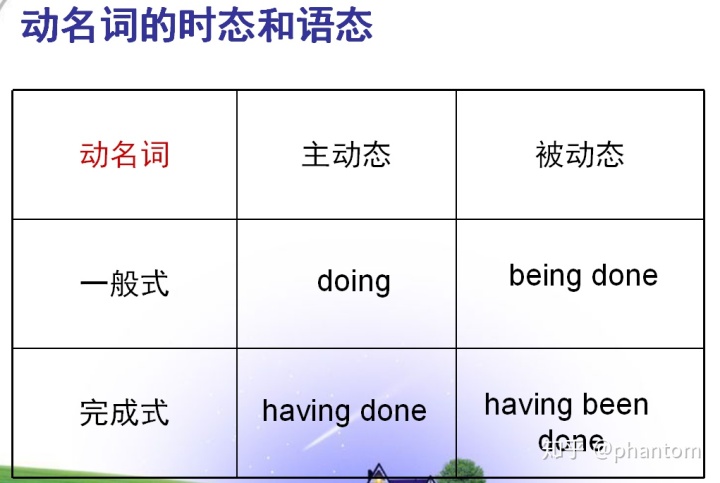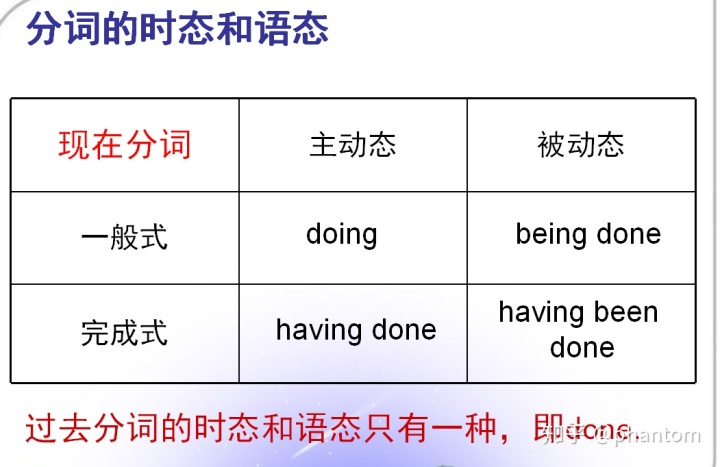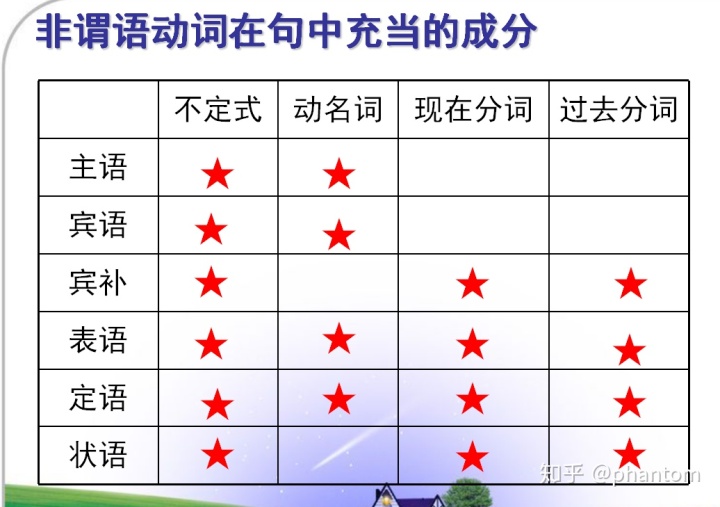本编文章主要内容:
一、非谓语动词的分类、特征
二、非谓语动词的时态和语态
三、非谓语动词充当的句子成分
四、补充知识点
非谓语动词概述:
英语中,动词具有两种形式: 1.谓语形式 2.非谓语形式
动词的谓语形式必须和主语在人称和数上保持一致,受主语的限定,因此又被称为动词的限定形式(Finite Forms of Verbs)。
非谓语形式不受主语的限制,因此又被称为动词的非限定形式(Non-finite Forms of Verbs)。
确切地讲,非谓语动词实际上指动词的非谓语形式。
动词的非谓语形式有三种:
1.不定式(The Infinitive),由to +动词原形构成,to 为不定式符号,并无实际意义。
2.动名词(The Gerund),由动词+ing构成。
3.分词(The Participle)
1)现在分词(The Present Participle),由动词+ing构成
2)过去分词(The Past Participle),由动词+ed构成。
非谓语动词具有以下特征:
非谓语动词可以做主语、宾语等多种句子成分,但唯独不能做谓语。
非谓语动词具有各种形态:原形、主动语态、被动语态、进行时态和完成时态。
非谓语动词具有动词的功能,如可以有自己的宾语,但不具有语法上的动词性质,如没有人称和数的变化。
例: Growing flowers is my hobby.
Thank you for helping us.
I hope to see you again.
使用非谓语动词的条件:
在一个句子中,已经存在一个谓语动词,而又没有连词的情况下,其他的动词就需要使用非谓语形式。
She got off the bus, __leaving_____(leave)her handbag on her seat.
She got off the bus, but __left___ (leave) her handbag on her seat.

1. 不定式的动作与谓语动词同时发生时,用一般式。
He wanted to see you.
2. 强调不定式的动作在谓语动词之前发生时,用完成形式。
He is said to have written a novel.
3. 强调不定式的动作正在进行时,用不定式的进行形式。
When I came in, he pretended to be reading a book.
4. 当不定式的逻辑主语是不定式动作的承受者时,用被动语态。
It is an honor for me to be asked to speak here.
The book is said to have been translated into English.

1.动名词的一般形式表示一般性动作或是与谓语动词同时发生的动作。
We are interested in climbing mountains.
I prefer singing to dancing.
2.如果强调动名词的动作已经完成,要用完成形式。
He was praised for having passed the exam .
3.如果动名词的动作发生在谓语动词之前,也要用完成形式。
He is proud of having been sent to work in Tibet .
4.当一个动名词逻辑上的主语是该动名词动作的承受者,这个动名词要用被动形式。
He remembered being taken to Beijing when he was a child.


如果强调一个被动的动作正在进行,要用分词的被动形式being done。
Being repaired, the building is forbidden to enter.
The house being built now is a Hope Project School.
如果强调分词表示的动作发生在谓语动词之前,要用完成形式。
Not having finished his homework,Tom was made to stay at school .
Having closed all the windows ,I went home.
Having been invited to the party ,Tom was very happy .
-----------------------------------------------------------------------------
非谓语动词的否定形式:
所有非谓语动词的否定形式都是直接在其前面加上not.
不定式的否定形式:not to do
动名词的否定形式:not doing
现在分词的否定形式:not doing
过去分词的否定形式:not done

动名词与不定式作主语时的区别
1.对称原则:主语和表语对称
Seeing is believing.
To see is to believe.
2.动名词做主语表示抽象的、经常性的动作,
不定式表示具体的、某一次的动作。
Climbing mountains is interesting.
To climb this mountain will take us two hours.
3.不定式做主语,一般用it 当形式主语,而把不定式短语后置。
It will take us two hours to climb the mountain.
固定句型:
1.It’s no use/no good /useless/worthwhile + doing …
在暗淡的灯光下看书不好。
It is no good reading in dim light.
2.It’s kind/wise/clever… of sb to do sth
It is very kind of you to help us.
3.It’s important/necessary/hard …for sb to do sth
我们学好英语很重要。
It is very important for us to learn English well.
不定式、动名词作宾语
He chose not to go home this weekend.
The manager desires to see you.
My mother dislikes seeing you with me.
He could hardly resist laughing.
He is fond of playing tennis.
动名词既可做动词宾语,也可做介词的宾语,而不定式只能做动词宾语。
有些动词只能接动名词做宾语,而有的只能接不定式做宾语,有的既可接动名词也可接不定式做宾语,但意义不同。
1.下列动词只能带动名词作宾语:
admit, allow, avoid, appreciate, consider, deny
enjoy, escape, finish, complete, forgive
keep, mind, miss, risk, resume, recall,
practise, prevent, resist, suggest, understand
be/get used to, devote oneself to,
look forward to, object to, prefer...to,
refer to, pay attention to, stick to, lead to
这些词组里的to为介词,而非不定式符号。
2.下列动词只能接不定式作宾语:
afford ,agree ,attempt, aim, choose
decide, demand, desire, determine,
expect, fail, help, hope, learn, manage,
offer, plan, pretend, prepare, promise,
refuse, seem, tend, threaten, wish
3.在一些动词后,可接不定式,也可接动名词做宾语,但含义有差别。
forget ,remember, regret +doing 表示动作已经发生;+to do表动作未发生
want, need ,require + doing 表被动 = to be done
try doing试着做; try to do 尽力做,想要做
stop doing 停止做某事
stop to do 停下来做另一件事
go on doing 继续做某事(前后是同一件事)
go on to do 接下来做某事(前后不是同一件事)
mean doing 意味着...,意思是...
mean to do 故意或想要做某事
can’t help doing sth 抑制不住、禁不住做某事
can’t help to do sth 不能帮忙做某事
4..在 begin ,start ,continue 等词后可接不定式作宾语,也可接动名词作宾语,意义区别不大,但要注意:
1)这些动词本身是-ing 形式时,其后要接不
定式;
2)主语是物,多用不定式;
3)其后的动词是表示情感的或与智力有关
的,不用 v-ing形式,而要用不定式,如:
know, realize, hate, love, understand , wonder, remember, forget
---------------------------------------------------------------------------------------
非谓语动词做宾语补足语
可以接不定式做宾语补足语的动词常用的有:
ask, want, advise, allow, encourage, force,
forbid,like, order, permit, persuade, request,
require, tell, warn, urge, expect
这些词后均可接+sb. to do sth.的结构
Father will not allow us to play on the street.
My teacher advised me to do more exercises.
常接分词做宾语补足语的动词有:
have,keep, get, find
see, hear, watch, notice etc.
I saw him working in the field yesterday.
He kept the water boiling.
I found my car missing.
I will have my watch repaired.
see, hear等词+sb.+do sth.与+sb.+doing的区别:
前者强调动作的真实性、完整性,后者强调动作的连续性、进行性。
I saw him work in the garden yesterday.
强调“我看见了”这个事实。
I saw him woking in the garden yesterday.
强调我见他正在干活这个动作。
---------------------------------------------------------------------------------------
非谓语动词作表语
1.不定式作表语(be to do):
按计划、趋势将要做的
She is to get married next week.
有责任、义务必须做的
I’m to see you off at the airport tomorrow
祈使、命令不得不做的
You’re to stand here ,do you understand ?
命运安排,注定做的
Disney met the mouse and he was to become a famous artist.
2.动名词作表语表明主语的性质或内容(有时可与主语互换)
My job is teaching you English.
Teaching you English is my job.
3.分词作表语表示主语的特点特征, 现在分词表示主动,过去分词表示被动和完成。
The book is interesting.
Skiing is more exciting than skating.
She felt confused, even frightened.
The guests are gone.
做表语的分词,其实很多已经转化为了形容词。
---------------------------------------------------------------------------------------
非谓语动词作定语
A. 动名词作定语表示被修饰词的用途
drinking water=the water that is (used )for drinking
drinking water, living room, sitting room, washing powder
B. 分词作定语,表被修饰词的特点、特征. 单个分词作定语前置,分词短语作定语放在所修饰词之后。
现在分词作定语表示正在进行和主动,过去分词作定语表示已经完成和被动。
boiling water 正在沸腾的水
boiled water 白开水(煮开过的水,可能是凉的)
a retired worker 一位退了休的工人
分词短语做定语相当于省略了的定语从句:
现在分词与被修饰词之间具有主动关系:
Due to the many changes taking place in our way of life, people's way of thinking has also changed a lot.
=Due to the many changes which take place in…
过去分词与被修饰词之间是被动关系:
Most of the people invited to the party were famous scientists.
=Most of the people who were invited to the …
C.动词不定式作定语
1.后置,表示将来
This is the Hope Project School to be built next year.
2.不定式与其所修饰的词之间可能是主谓或动宾关系:
The train to arrive is from London.
I have a lot of work to do .
I want to get something to read .
Do you need some water to drink?
3.当名词有特定的定语, 如形容词副词的最高级,序数词及next, only, right等,其后接不定式作定语。
He is the first student to come and the last to leave.
Where is the best place to meet ?
We need the next room to hold corn.
4.不定代词something, nothing, little, much等习惯上用不定式做定语。
There is nothing to worry about.
5.如果动词要求用不定式做宾语,则它们相应的名词一般也要用不定式做定语,如:
decide to do, wish to do
His wish to buy a car came true.
Their decision to give up the experiment surprised us.
6.不及物动词构成的不定式做定语,要加上适当的介词,这里的介词不能省略。
I need a pen to write with.
---------------------------------------------------------------------------------------
非谓语动词作状语
不定式做状语,表示原因,目的或结果。为了强调目的,可与in order to或so as to 连用。
I reached home only to find my old dog dead .
He got up early to catch the early bus .
To improve our English, we come here.
I’m so glad to see you.
They went to the railway station, only to be told that the train had left.
注:only + 不定式”常表示出乎预料的结果.
分词作状语可以表示时间、条件、原因、结果、伴随或方式,及独立成分。分词与逻辑主语的关系是主动的,用现在分词,反之,用过去分词。
Hearing the news, he couldn’t help laughing.(时间)
Given enough time, I can do it better. (条件)
Being ill, he didn’t go to school (原因)
The glass fell to the ground, breaking into pieces. (结果)
Our teacher came in, followed by many students (伴随)
Generally speaking, one must be confident.(独立成分)







 本文详细介绍了非谓语动词的分类、特征、时态和语态,以及它们在句子中充当的角色。非谓语动词包括不定式、动名词和分词,它们可以做主语、宾语等,但不能作谓语。非谓语动词具有动词功能,但无主语和数的变化。文章通过实例解析了不定式、动名词和分词的用法,以及它们在表示动作先后、语态和具体情境中的差异。此外,还讨论了非谓语动词的否定形式和在主语、宾语、表语、定语和状语中的应用。
本文详细介绍了非谓语动词的分类、特征、时态和语态,以及它们在句子中充当的角色。非谓语动词包括不定式、动名词和分词,它们可以做主语、宾语等,但不能作谓语。非谓语动词具有动词功能,但无主语和数的变化。文章通过实例解析了不定式、动名词和分词的用法,以及它们在表示动作先后、语态和具体情境中的差异。此外,还讨论了非谓语动词的否定形式和在主语、宾语、表语、定语和状语中的应用。

















 被折叠的 条评论
为什么被折叠?
被折叠的 条评论
为什么被折叠?








